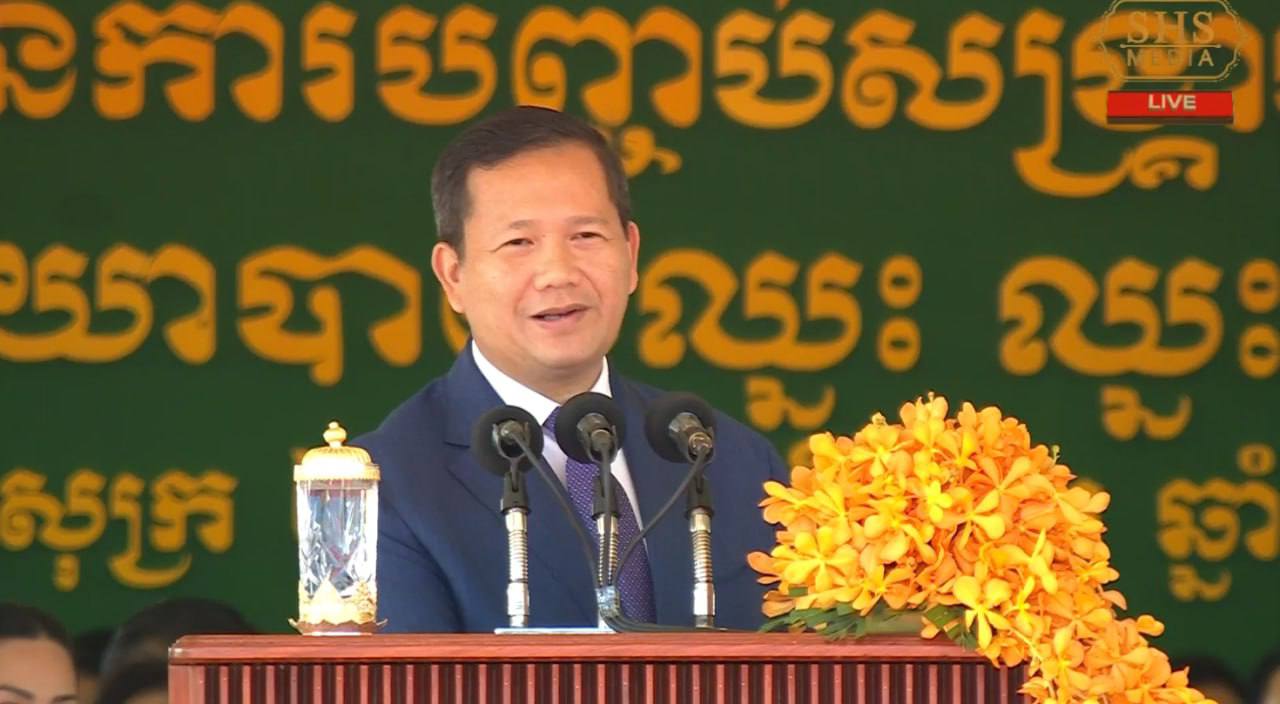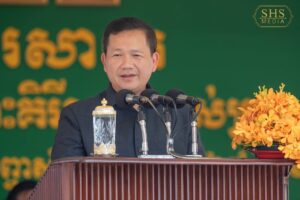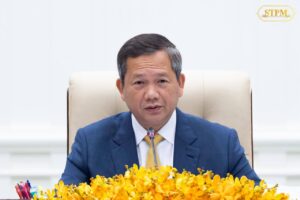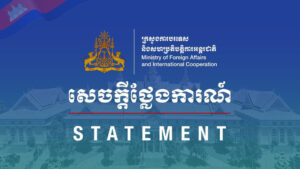Selected Comments Samdech Moha Bovor Thipadei Hun Manet, at the celebration of the 25th anniversary of the end of the civil war, the successful implementation of the win-win policy, and the fifth anniversary of the construction of the Win-Win Monument
 Selected Comments Samdech Moha Bovor Thipadei Hun Manet, at the celebration of the 25th anniversary of the end of the civil war, the successful implementation of the win-win policy, and the fifth anniversary of the construction of the Win-Win Monument
Selected Comments Samdech Moha Bovor Thipadei Hun Manet, at the celebration of the 25th anniversary of the end of the civil war, the successful implementation of the win-win policy, and the fifth anniversary of the construction of the Win-Win Monument
We thank peace, thank the win-win politics, and are grateful to the founding leader, and operators of the win-win politics who bring about the complete peace and national unity!
[1]
This (win-win monument) place is a favorable location. However, the achievements that we see today do not come naturally. (1) Both the location and the land, the negotiations, the fundraising and the preparation of the master plan with meaning and construction had to be carefully considered/planned and worked hard. Without high commitment, it would be impossible to achieve it. I witness the determination and commitment of Samdech Pichey Sena in building this historic monument from the beginning. I thank Samdech Pichey Sena for his wise leadership and hard work in organizing this historic monument […]
I thank and commend the efforts of the leaders of all parties of the Construction Committee (2) for promoting and paying attention to make this historical monument connecting with numerous historical aspects of Cambodia in the period of harmony through to the break of war, and the war’s aftermath […] on one side, we have a number of temples that represent harmony when our country grew and united. On the other side, we have the Techo Santepheap Park, where we display the war equipment […] and nearby, we have a park where the CMAC (Cambodian Mines Action Centre) and the Peace Center have set up a display of various kinds of bomb (used during the war) […] at the center, we see that the Win-Win Monument was designed to describe the efforts and leadership of (the win-win policies) founder and leader, Samdech Techo, as well as the key operators who not only ended the war on December 29, 1998, but making rooms for further description in connection with current developments […]
(3) (We have come up with this arrangement) so that those who would be here could see the evidence of war and the efforts to end the war and to build up peace in just a moment or in one round tour. That will make them know the value of peace more firmly. To know the value of peace one has to see how miserable it is when peace is lost. The data of the deadly bombs and the military tools that used to kill each other can also confirm to us the next generation of Cambodia that war is not what we want. We must work together to protect peace […]
(4) There has been a question if this Victory Monument is built to glorify Samdech Techo or some core operator and/or leaders? […] Indeed, Samdech Techo is the founding leader, who set out the win-win political strategy and lead a smart execution. However, it would not have been successful for the win-win politics leader to do it alone, without the honest participation of operators. Many of the core operators and leaders are here present on this forum, and they have been involved as key and loyal actors. Without sincere participation, we cannot end the war and ensure the sustainability of peace […]
(5) The win-win politics comes from the leadership and the wise policy of Samdech Techo, the infamous founding leader, with the sincere participation of all core operators and operators, and the people. If we talk about the results, everyone, those who criticize, who do not trust, and who do not believe, and remain skeptical of the win-win politics benefits from the peace that the win-win politics makes […]
Now, why the Win-Win Monument? […] everyone certainly wants an end to the war, does not want (his/her life and country to experience) misery. (6) This Win-Win Monument was built for all Cambodians to celebrate the achievements realized by all Cambodian parties, as well as to reminder our history so that the next generation of Cambodians will remember the value of peace and the historical facts. If we do not remember history, we cannot move forward. We will be lost. We need to have a clear historical identity […]
Researching, compiling various documents to disseminate to the next generation of Cambodian children to learn, and to keep records of various pieces of important evidences of military histories. Let this peace continue forever to ensure the development of our nation […] (7) Hopefully, these and other achievements will continue to be built and carved on these walls. Let me emphasize that this Win-Win Monument is not for honoring someone or any groups, but for the record keeping as a testimony for Cambodian children and foreigners to see our historical journey […]
[2]
[…] (8) Why did the win-win politics in Cambodia end the war sustainably? […] let me emphasize that we have the key principles such as the three guarantees and the DIFID strategy. However, the real key is trust. These three guarantees cannot end the war without trust […]
Samdech Techo, who is the guarantor (of the implementation of this win-win policy) himself […] confirmed that there is no document written and/or agreement signed. It is purely a a guarantee with trust. (9) (If there were an agreement on) paper, it would not have mean anything, because it would just be only the contract paper […] however, (the parties to the implementation of this policy), first of all, have trusted Samdech Techo as a guarantor and second of all, the Khmer Rouge leaders at all levels believed in themselves, trusted their own eyes, and trusted their own ears […]
They have seen with their own eyes and heard with their own ears that those who joined the government previously (are really safe) and (10) the two smart elements of the DIFID strategy – integration and practical development – have indeed increased credibility. This is why the win-win politics is successful as it increases trust, and this trust is not on paper, but on the ground (obviously) – impunity, assurance of wealth, life, and retention of their official functions […] this is different from a ceasefire in which all parties would cease fire, but there are no conditions for building trust. Some places stop for decades, but one day, explosion could have happened anytime again because both sides still hate and do not trust each other[…]
[3]
As for the question if the war is not over 25 years ago, what will the situation be like? (The answer is to ask) a simple question. For the army standing here, the police standing here, if the war is not over, how many can be absent due to deaths and injuries. How many of our officers on this platform could have lost their lives? How many women, how many children, became widows and orphans? […] (11) officers from one side in the former state of Cambodia and the other in the former Khmer Rouge have now discussed combat experiences, […] had food together, and lead the national defense plan together […]
(12) There is no benefit (from) war […] nothing but taking lives, especially the war that the Cambodians would kill each other. On the contrary, great benefit comes from peace. We can measure […] we ended the war 25 years ago and you are all here. Our officers and soldiers have the opportunity to unite irrespective of who they formerly beoned, but as the unified Royal Cambodian Armed Forces who together protect the peace and stability of the country and for the people […]
(13) I went down to many provinces to declare mines free area/provinces. By this time, more than half (of the provinces in the country are mines free). If there is no win-win policy to end the 1998 war, one may ask how many provinces would have the chance to declare mines free? Not only that it would not be without mines, but also the number of mines would be increasing. In that case, one can ask how many more people will continue to die from landmines? (Declaring mines-free provinces) is the result of our win-win politics and the end of the war […]
[4]
The word “former battlefield” means it was a place where people killed to conquer. They laid down mines not only to take people lives, but also make the areas ghostly, and/or uncultivated […] (14) Now along the border, we have transformed the misery war-torn areas into the development areas. The simplest development we can see and say is to make people rich, have peace, have the opportunity to learn, have the opportunity to do business, and have the opportunity to build a pagoda, etc. […] (15) We clear all the mines, and we build villages. This is the definition of transforming from war, division, doom of human and animals, risky geography and land into a place for the development of our nation […]
[5]
The win-win politics does not only benefit us. As Cambodia is peaceful, the region is also peaceful […] the current conflict in Myanmar also extends its impacts in the region […] (16] As Cambodia has peace, Cambodia strengthens its role in maintaining peace and economic development in the region. Not only that, we also participate in peacekeeping in other countries in the world. We now have more than 8,000 peacekeepers on missions in many countries. Demining troops have been involved in demining training, and humanitarian assistance in some war-torn countries. Therefore, (17) the fruits of the win-win politics are not only for the Cambodian nation, the descendants of Cambodia now and in the future, but also for other countries in the region and in the world […] ending the war helps us improve the economy and reduce poverty for the people […]
[6]
There is no more fighting (in Cambodia). People learn to work, to help families and the nation […] (18) peace creates choices/opportunities for the younger generation, especially our children (of the next generation) in areas where there had been war activities before. (There are) veterans who have survived (the war and have) their children benefited from this development. All these benefits are not only for the present, but for future Cambodian children and for hundreds of thousands of years to come. We must be committed to maintaining peace and national development, (thanks to the) end of infighting/war (that divided Cambodia) in 500 years, on December 29, 1998, and will continue to bear fruit in the future for Cambodian generations to come […]
[7]
Before I finish (19), please join together to fulfill the following five points:
First, encourage continued research and documentation on the win-win politics, and processes related to the search for peace and the end of the war in Cambodia […] there are more experiences to learn and more angles to look at […] since the compilers/researchers are the ones who executed the policies personally, they know a lot of information and can gather more ingredients to compile for future generations. Otherwise, in the next 20-30 years, or 50 years, new researches would be the results of the authors who conducted the paper researches […]
Second, continue to disseminate the content of the win-win policy through seminars, forums, as well as integrate historical content related to win-win policy in the curriculum so that students have a deeper understanding and value of the win-win policy […]
Third, continue to research and organize the win-win monuments in key areas, as well as organize some important military sites with historical significance for evidence and for study visits […]
Fourth, pay attention to mobilizing and finding partners to build and maintain the win-win monument, a symbol of our country’s peace. I would appeal to the benefactors, the tycoon, and the generous people to continue to support this work […]
(5) I thank the efforts of the leadership in the construction committee, as well as the participation of our people from all walks of life in the records keeping as well as historical evidence through building and organizing various historical sites […]./.






